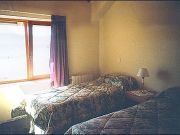Pehuén or Araucaria's Legend See map
Since always Nguenechén made the pehuén to grow in large forests, but at first the tribes that inhabitated those lands did not ate the piñones because they believed they were poisonous.
They considered a sacred tree to the pehuén o araucaria and worshiped it praying in its shadow, offering gifts: meat, blood, smoke, and even they talked to it and confessed their evil deeds. The fruits were left on the floor without using them.
But it happened that in the whole region there were a few years of great scarcity of food and went hungry, especially children and elderly dying. In this situation young people marched away in search of food: amancay bulbs, herbs, berries, roots and wild animal's meat. But all returned empty-handed, it seems that God did not hear the cries of His people and people were still starving.
But Nguenechén did not abandon them, and it happened that when one of the boys became discouraged met an old man with long white beard.
- What do you want, son? -He asked
- Some food for my brothers of the tribe who are starving. Unfortunately I have not found anything.
- And so many piñones that you see in the floor under the pehuenes, are not edible?
- The fruits of the holy tree are poisonous grandfather. -answered the youth.
- Son, now on receive food as a gift from Nguenechén. Boil them to soften or toast them on fire and you will have a delicious dish. Make good collection, store them in underground sites and you will have food all winter.
Said so, the old man disappeared. The young man, following his advice, picked up many piñones and took them to the chief of the tribe, explaining what had happened. Then gathered all and the chief told what had happened by talking like this:
- Nguenechén had come down to earth to save us. We will follow his advice and we will eat the fruit of the sacred tree that belongs to him alone.
Then they ate plenty of boiled or roasted piñones, making a great party. Since then shortages disappeared and they harvested every year large quantities of piñones that kept underground and kept fresh for a long time. They also learned to make the chahuí with piñones, a fermented beverage.
Every day, at dawn with a piñon in the hand or a sprig of pehuén, they pray facing the sun: "To you we owe our life and to please you, the great, to you our father, that do not let die the pehuenes. They must spread as spread our descendants, whose life belongs to you, such as sacred trees belong to you".
Araucaria
It is the typical tree of Neuquén, ranging its habitat from Copahue to Lake Huechulafquen. It can reach 40 meters high and its shaped is like a pyramid when is young and later a huge umbrella. It has a very slow growing. Its branches are slightly curved upwards with hard, pointed leaves. Its flowering is unisexual, some trees produce pollen and others give the pineapple that is fertilized by pollen carried by wind. Once mature, each pineapple has between 200 and 300 piñones and each tree can grow about 30 pineapples.
These piñones are very nutritious and were the staple of the indigenous Pehuenche, who who consumed it boiled or roasted and produced fermented beverages with it. They also used the resin secreted from the bark of the tree as healing medicine. It was considered a sacred tree and some of its branches made the rehue (altar) in its Nguillatún (supplication to God).
Alojamiento en Caviahue
 Apart Hotel Lago Caviahue
Ubicado en la costa del Lago Caviahue nuestro stablecimiento lo espera todo el año con todos los servicios y la mejorver másTel: +54 2948 49-5074Caviahue
Apart Hotel Lago Caviahue
Ubicado en la costa del Lago Caviahue nuestro stablecimiento lo espera todo el año con todos los servicios y la mejorver másTel: +54 2948 49-5074CaviahueViajes por la Patagonia
Related Articles
© Patagonia.com.ar 2025 | Todos los derechos reservados.
